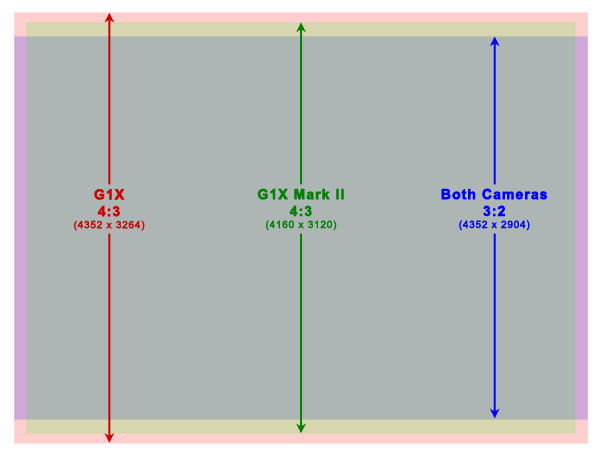Canon G1X Mark II First Shots Posted! The highly anticipated G1X follow-up lands in our test lab
posted Wednesday, April 2, 2014 at 5:05 PM EDT

Canon's only large sensor, fixed lens compact camera, the G1X from 2012, recently received a long-awaited makeover in the form of the G1X Mark II which has just completed the first leg in our lab test series. Our First Shots allow you to take a close-up look at our Still Life target images across the ISO range at default JPEG settings, and to also compare the G1X Mark II to its predecessor, or to any other camera we've ever tested, using our world-renowned Comparometer.
As a special note to readers who've yet to read our G1X Mark II preview, below is an in-depth description of why we chose to shoot these test shots in a 4:3 aspect ratio, as opposed to the default setting of 3:2, written by our publisher Dave Etchells:
"Here at IR, we normally shoot cameras in whatever their default modes are, figuring that most users will do the same. In the case of the Canon G1X Mark II, though, we opted to shoot our laboratory test images at the 4:3 aspect ratio, vs the 3:2 that's the default. We did so for two reasons. For one, it's the highest-resolution mode, by a whisker (12.98 megapixels vs 12.63), but more importantly, so that readers could better compare images from it and the original G1X in the Comparometer and in our comparison crops that will be added to the review itself.
The G1X II takes an unusual approach in how it generates 4:3 and 3:2 aspect ratios, one that makes a lot of sense, and that we've seen before in some older Panasonic models, but not for a little while now.

The illustration above shows the relative pixel dimensions of the 4:3 and 3:2 aspect ratios of the two cameras. The original G1X had a 4:3 aspect ratio sensor, and created its 3:2 ratio images simply by lopping off the top and bottom of the frame. One consequence of this is that the corners of the 4:3 ratio images extended further out from the center, so were more prone to optical shortcomings as they approached the limits of the lens's image circle.
By contrast, in switching from 4:3 to 3:2 mode, the G1X Mark II shortens the vertical dimension somewhat, but at the same time, increases the width. This approach means that the corners of both the 4:3 and 3:2 images use the same amount of the lens's image circle. Optical performance in the corners of images with both aspect ratios will be about the same.
In the original G1X, the higher-resolution 4:3 aspect ratio was its default, while in the G1X Mark II, 3:2 is the default. (Perhaps to mimic the ratio most DSLR shooters are familiar with.)
Following the industry convention for comparing resolution between cameras having different aspect ratios, our test shots are set up so the subject fills the same percentage of the frame vertically. Particularly in the case of our Still Life subject, which is only a little wider than it is tall, this makes sense, since that will best fill the frame with the subject. Wider aspect-ratio cameras simply show more blank space on the left and right.
Given this framing, shooting the G1X Mark II in its default 3:2 mode would have resulted in less resolution (fewer pixels on the subject) than at 4:3. Comparing the G1X Mark II at 3:2 with the original model at 4:3 would have further increased the apparent difference, when the actual difference in vertical resolution between the two cameras (the value that's most relevant to the Still Life target) is actually fairly modest, at 3,120 vs 3,264 pixels, a difference of less than 5%, vs the more than 12% difference, had we shot at 3:2.
All this is perhaps more explanation than is called for, but we wanted readers to understand why we didn't use the G1X Mark II's default aspect ratio for our shots. (And it also highlights and explains Canon's clever avoiding of the most extreme edges of the G1X Mark II lens's image circle.)"
So, now that you're aspect ratio savvy, go take a look at the images for yourself! And feel free to come back to this page and make comments below if you find anything interesting in your own comparisons.